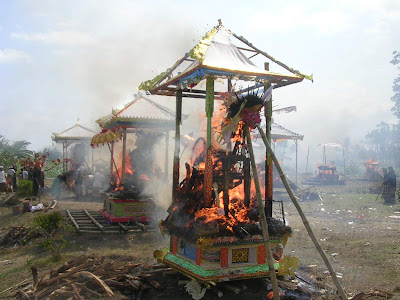Ngaben, or Cremation Ceremony, is the ritual performed in Bali to send the deceased to the next life. The body of the deceased will be placed as if sleeping, and the family will continue to treat the deceased as sleeping. No tears are shed during the ceremony, because death is considered temporary and the deceased will either reincarnate or find his final rest in Moksha (free from the reincarnation and death cycle).
To decide the proper day for the ceremony the family would consult a priest. On the decided day, the body of the deceased will be placed inside a coffin. This coffin is placed inside a sarcophagus resembling a buffalo (Lembu) or in a temple structure (Wadah) made of paper and wood. The shape, size, and elaborateness of the sarcophagus varies according to the social and financial status of the family. The sarcophagus will then be carried to the cremation site in a procession. The procession will move in a winding pattern to confuse bad spirits and keep them away from the deceased.
The climax of Ngaben is the burning of the whole structure, together with the body of the deceased. The fire, together with the chanting of priests is believed to be able to free the spirit (atma) from the body, cleanse it and enable reincarnation.
Not all deceased is allowed a ngaben ceremony. One such exception is an infant (indicated by not yet having any teeth), because they are believed to be free of sin and so does not require the ceremony to reincarnate.
Ngaben is not always immediately performed. For higher caste members it is normal to perform the ritual within 3 days. For lower caste members the deceased are buried first and later, often in a group ceremony for the whole village, cremated. This practice of mass cremation is the reason that now there seems a certain time within a year (usually between June and August) that is considered the Ngaben season.
Various Sarcophagus
 |
| A low caste sarcophagus |
 |
| Mass Cremation |
The Procession











